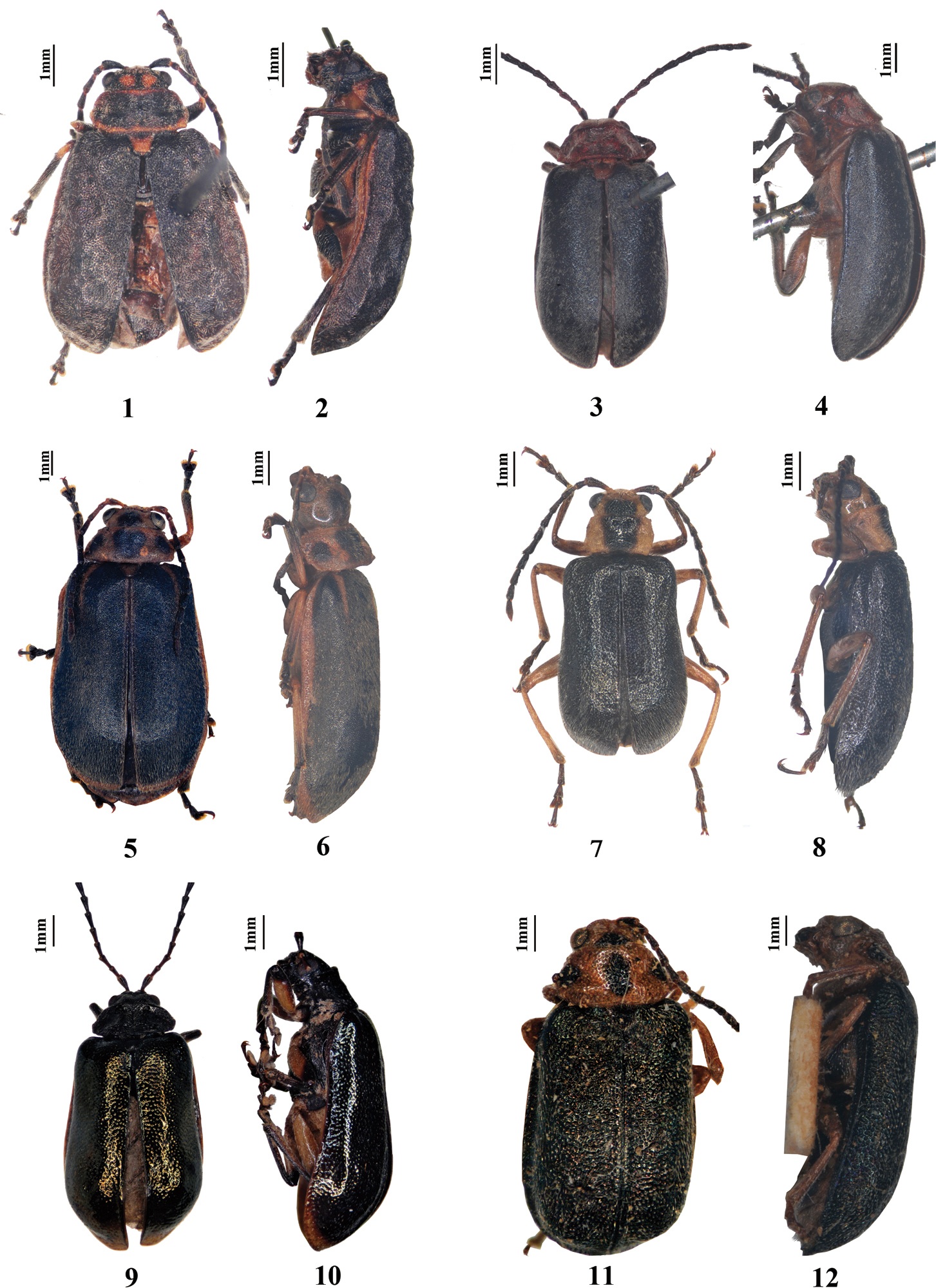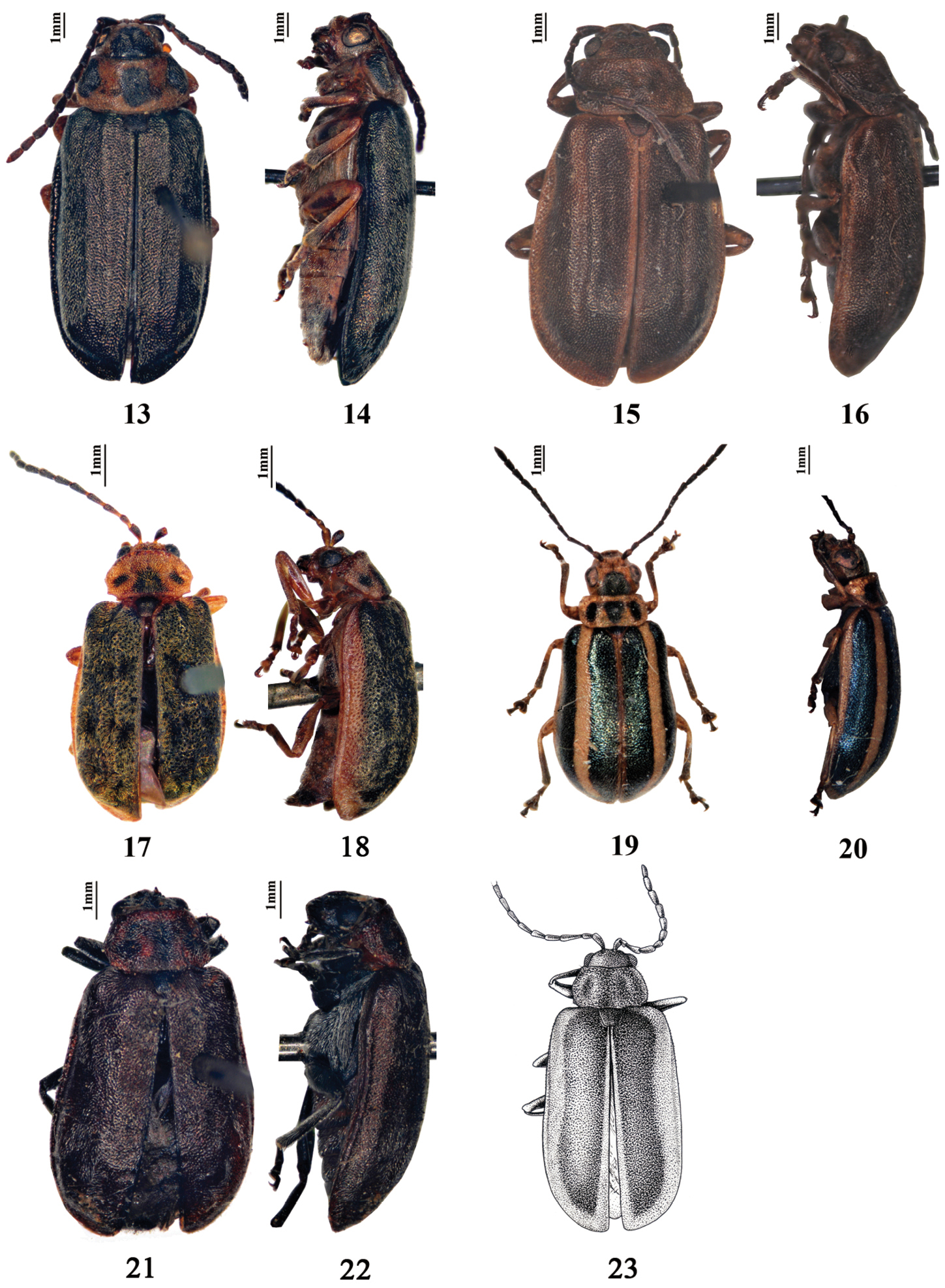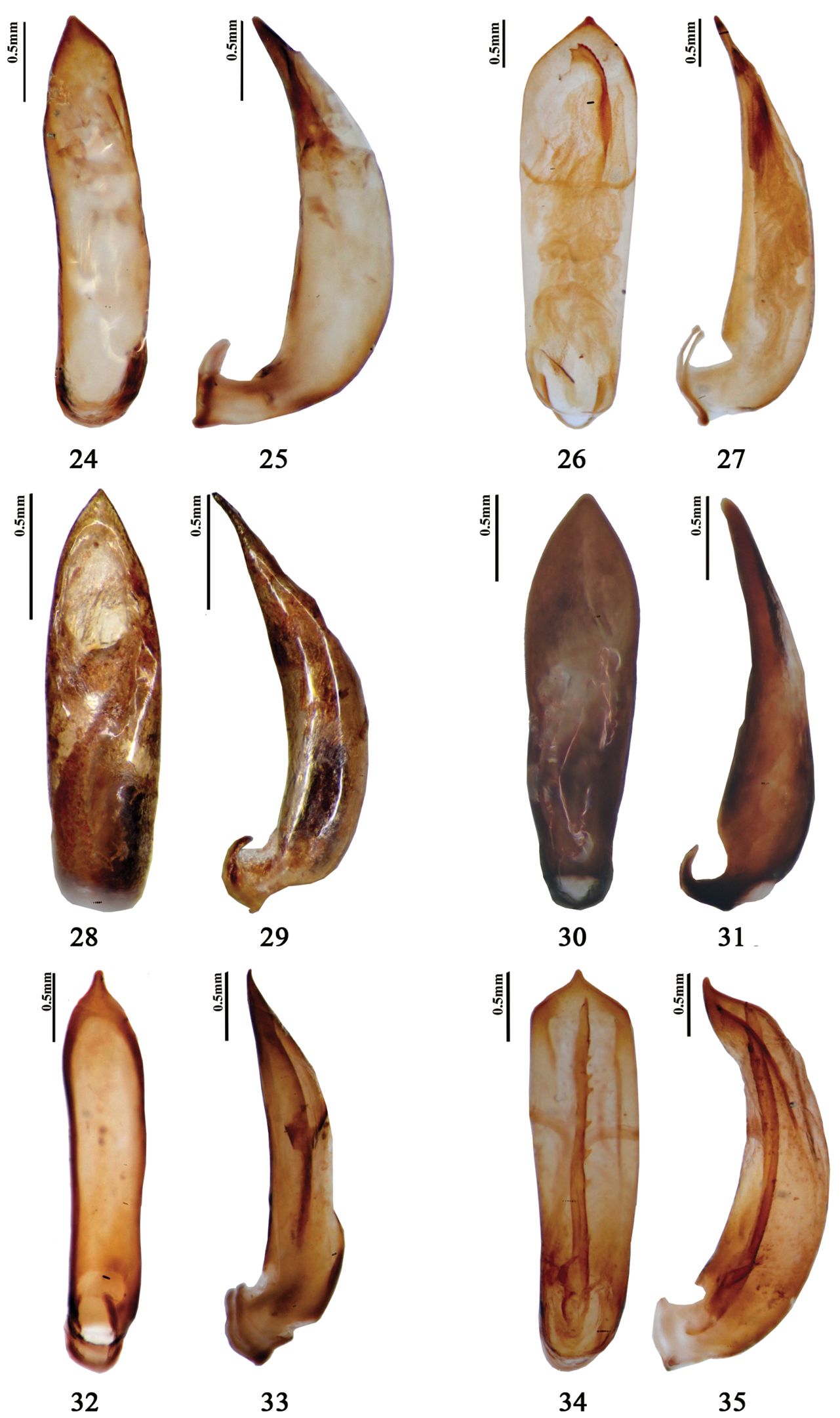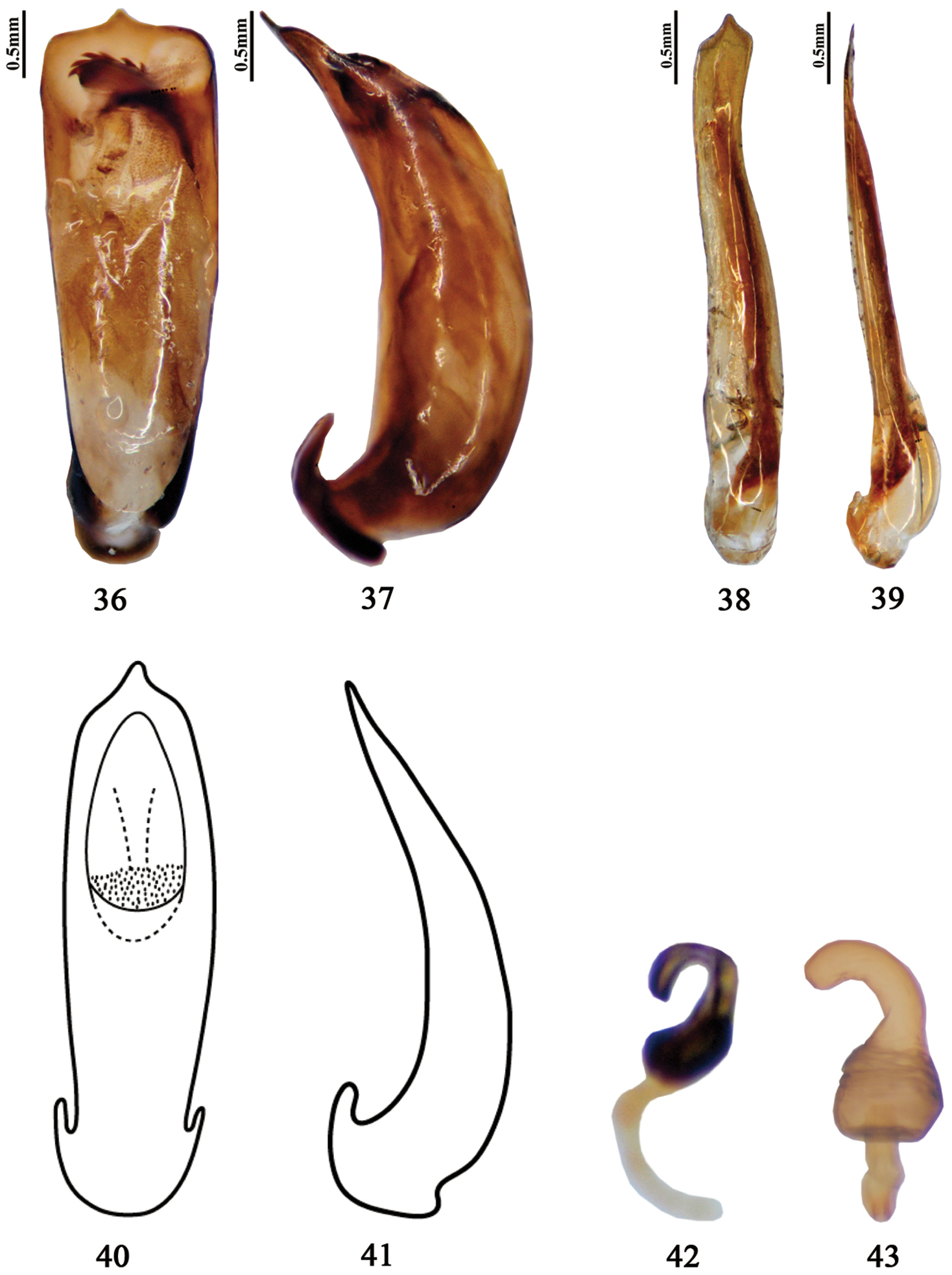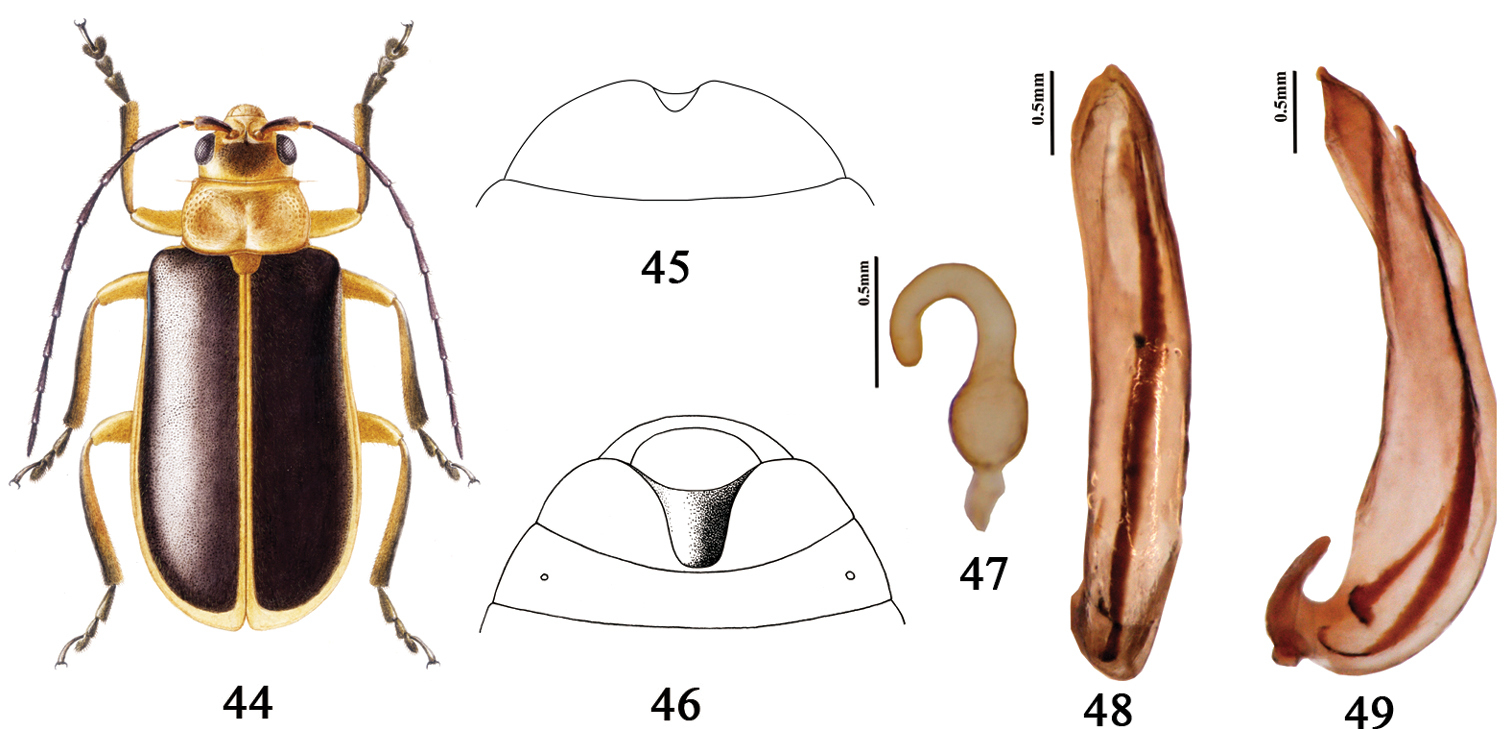






(C) 2013 Rui-E Nie. This is an open access article distributed under the terms of the Creative Commons Attribution License 3.0 (CC-BY), which permits unrestricted use, distribution, and reproduction in any medium, provided the original author and source are credited.
For reference, use of the paginated PDF or printed version of this article is recommended.
Thirteen species of Pyrrhalta Joannis, 1865 with black elytron are reviewed. A key to species, photographs of aedeagus and habitus are provided. Pyrrhalta qianana sp. n. is described from Guizhou, China. Pyrrhalta martensi Medvedev & Sprecher-Uebersax, 1999 is newly recorded from China (Tibet).
Coleoptera, Galerucinae, Pyrrhalta, black elytron, new species, key
The genus Pyrrhalta Joannis, 1865 is a large, worldwide genus distributed in the Holarctic, Oriental and Australian Regions. The genus was firstly proposed as a subgenus of Galeruca Geoffroy, 1762 by Joannis (1865), and Galeruca viburni Paykull, 1799 was deemed to be fixed as type species by monotypy. The genus presents serious difficulties in several aspects of its classification and nomenclature. Firstly, this genus is very large including 115 species in the world (
This study focuses on the Pyrrhalta species with black elytra, which may not be a natural group. We defined the main character state of the group as “elytra entirely or at least 2/3 black”. There are 13 species included in this group. Among them, Pyrrhalta qianana sp. n., a new species described below. A key to the species of the group is provided.
Morphological characters were examined with an Olympus SZ 61 microscope. Genitalia of males and / or females of each species were dissected using the following procedure: for dried or ethanol preserved specimens, the abdomen was separated, transferred to a vial containing 10% KOH which was heated in a boiling water bath for 10 min. The genitalia were then carefully removed in a cavity slide under distilled water using fine forceps and hooked minuten-pin dissecting needles. Series of partially focused photographs were made with a digital camera (Nikon D300S) attached to a stereomicroscope (Zeiss Discovery V12), and then combined using Helicon Focus software, and finally were evaluated and assembled using Adobe Photoshop CS 8.0 and Illustrator CS4 software.
BMNH The Natrual History Museum, London, UK
IZAS Institute of Zoology, Chinese Academy of Sciences, Beijing, China
JBCB Jan Bezděk collection, Brno, Czech Republic
MHBU Museum of Hebei University, Baoding, Hebei, China
NHMB Naturhistorisches Museum Basel, Switzerland
USNM The United States National Museum of Natural History (Smithsonian Institution), Washington, D.C., USA
ZIN Zoological Institute, Russian Academy of Sciences, Saint-Petersburg, Russia
| 1 | Head and pronotum yellowish brown, with or without black markings | 2 |
| – | Head and pronotum dark, with or without brown markings | 10 |
| 2 | Occiput without black spots | 3 |
| – | Occiput with black spots | 4 |
| 3 | Elytron entirely black with flattish surface, space between punctures smaller than diameter of puncture | Pyrrhalta huangshana Chen, 1964 |
| – | Elytron black, suture and lateral margins light yellow; elytral surface convex, space between punctures larger than diameter of puncture | Pyrrhalta qianana sp. n. |
| 4 | Middle of pronotum with black reversed trapezoid marking | Pyrrhalta meghalayana Medvedev, 2002 |
| – | Pronotum with three black spots, located in both lateral sides and middle of disc | 5 |
| 5 | Elytron black, a short yellowish brown longitudinal stripe present at base of elytron, which less than 1/4 of elytral length | Pyrrhalta martensi Medvedev & Sprecher, 1999 |
| – | Elytron black, without yellowish brown stripe or with a long yellowish brown longitudinal stripe through the whole elytron | 6 |
| 6 | Elytron surface with ridges | 7 |
| – | Elytron surface without ridges | 8 |
| 7 | Elytron dark metallic bronze with slight shade of olive green; with two distinct longitudinal ridges close to suture and flat margin | Pyrrhalta subaenea (Ogloblin, 1936) |
| – | Elytron black, lateral margin and epipleuron brown, disc with 7 irregular black spots formed by groups of dense punctures, short yellowish band present at base of elytron which is the same length as scutellum; longitudinal ridge in middle of disc and under humerus | Pyrrhalta tianmuensis Chen, 1964 |
| 8 | Elytron black, each with yellow longitudinal stripe starting side of humerus and ending before elytral apex, elytral margin and epipleuron brown | Pyrrhalta warchalowskii Bezděk, 2007 |
| – | Elytron black or reddish brown or brown black, without yellow longitudinal stripe, elytral margin and epipleuron brown or black | 9 |
| 9 | Antenna 1/3 as long as elytra; basal margin of pronotum slightly concave in middle, lateral margin clearly convex in 1/2; elytron entirely black, disc convex with dense, deep punctures | Pyrrhalta orientalis (Ogloblin, 1936) |
| – | Antenna 1/2 as long as elytra; basal margin of pronotum sinuate, lateral margin narrow basally, obtusely rounded anteriorly; elytron black, basally, along suture, with stripe in middle of disc, lateral margin and epipleuron brown, disc with dense, small, and shallow punctures | Pyrrhalta sulcatipennis (Chen, 1942) |
| 10 | Occiput with two brown spots; pronotal disc with six small depressions | Pyrrhalta fossata (Chen, 1942) |
| – | Occiput without two brown spots; pronotal disc with three depressions | 11 |
| 11 | Elytron reddish brown with broad longitudinal blackish marking covering nearly all interior 2/3 of disc | Pyrrhalta tatesuji Kimoto, 2001 |
| – | Elytron without blackish marking | 12 |
| 12 | Antenna slender; pronotum with V shaped depressions besides of disc, a triangle concave near middle of basal margin; elytron bronzy black with purplish or bronzy tinges metallic lustre, lateral margin not with expanded margin | Pyrrhalta metallica Gressitt & Kimoto, 1963 |
| – | Antenna very stout; pronotum with a wide longitudinal depression in the middle of disc, round depressions besides of disc; elytron brown black, different shades, with bronze metallic lustre, lateral margin expanded with a swollen ridge parallel to margin | Pyrrhalta xizangana Chen & Jiang, 1981 |
http://species-id.net/wiki/Pyrrhalta_fossata
Figs 1–2, 42Type material: Holotype: ♀, re-written (original label is in Chinese): China, Sichuan, Kangding, 25-VIII-1939, collector unknown (IZAS).
China (Sichuan).
Holotype of this species was diagnosed as male in the original description without being dissected (
Habitus. 1–2 Pyrrhalta fossata (holotype) 3–4 Pyrrhalta huangshana (holotype) 5–6 Pyrrhalta martensi (paratype) 7–8 Pyrrhalta meghalayana (paratype) 9–10 Pyrrhalta metallica 11–12 Pyrrhalta orientalis (holotype).
http://species-id.net/wiki/Pyrrhalta_huangshana
Figs 3–4, 24–25Type material: Holotype: ♂, re-written (original label is in Chinese): China, Anhui, Huang Mountain, 5-VIII-1936, collector unknown (IZAS).
China (Anhui).
Aedeagus of the holotype is illustrated here (Figs 24-25), dorsal view: asymmetrical but nearly parallel-sided, tapered at extreme apex which is subacute; dorsal opening largely on the left side; lateral view: gradually tapering to a subacute tip, slightly arched on the left side, nearly semi - circular on right side.
http://species-id.net/wiki/Pyrrhalta_martensi
Figs 5–6, 26–27Type material: Paratypes: 1 ♀, original label: “W-Nepal, Kali Gandaki, Knola C.J. Rai / Kopchepani, 1500–1600 m, 21-V-1984 / PARATYPUS, L.N. Medvedev” (NHMB); 1♂, original label: “India, Darjeeling D., Bhakta B. / Kalimpong, 9th mile 1500 m, 14.VII84 / PARATYPUS, L.N. Medvedev”(NHMB).
Other material (2 spec.): 2♂, China, Tibet, Linzhi, Muotuo, Yarang, 760m, 19-VIII-2006, Ming Bai leg. (IZAS).
China (Tibet), India, and Nepal.
This is the first record of this species in China.
http://species-id.net/wiki/Pyrrhalta_meghalayana
Figs 7–8, 28–29Type material: Paratypes: 1♂, 1 ♀, original label: “NE INDIA; Meghalayana; 1999, 3Km E Tura; 1150; 25°30'N, 90°14'E; 18. IV.; Dembický & Pacholátko leg. / PARATYPE” (NHMB).
Other material (1 spec.): 1 ♀, NE India, Meghalaya, SW of Sohra, 25°13–14'N, 91°40', 700–950m, 22-V-2005, C.L. Peša leg. (JBCB).
India.
http://species-id.net/wiki/Pyrrhalta_metallica
Figs 9–10, 30–31Type material: Allotype: 1♀, original label: “near O-Er., Nr Weichow, Aug. 6 18 ‘33, 6000–1500 ft / SzechwanChina, DCGraham / ALLOTYPE J.L. Gressitt” (USNMNH).
Other material (3 spec.): 2♂, China, Yunnan, Yundi, 3700m, 28-VII-1979, Jiang-Xing Rao leg. (IZAS); 1♂, China, Yunnan, Yundi, 3700m, 28-VII-1979, Zhi-Wen Kui leg. (IZAS).
China (Sichuan, Yunnan).
http://species-id.net/wiki/Pyrrhalta_orientalis
Figs 11–12, 32–33Type material: Type: ♂, original label: “Shan-hai-Kwan, In Mountains, 1.9.06., F.M. Thomson, 1907-200 / Galerucella orientalis sp. n., D. Ogloblin det., 1935. type.” (BMNH).
Other material (44 spec.): 1♂, China, Beijing, Badaling, 700m, 23-VII-1964, Qin Zhou (IZAS); 1♀, China, Beijing, Badaling, 27-V-1980, collector unknown (IZAS); 2♀, China, Beijing, Shanbao, 26-V-1978, Sheng-Qiao Jiang leg. (IZAS); 1♂, China, Beijing, Shanbao, 4-VII-1978, Sheng-Qiao Jiang leg. (IZAS); 1♂, China, Beijing, Shanbao, 09-VII-1964, Su-Bo Liao leg. (IZAS); 19♀, 19♂, China, Shandong, Tai Mountain, 21-IV-1993, Cheng-Gang Zhou leg. (IZAS)
China (Liaoning, Hebei, Shanxi, Shandong, Fujian).
Aedeagus is illustrated here (Figs 32–33), dorsal view: slightly asymmetrical, gradually and slightly widened to apex, apex with a long acute tip; lateral view: nearly straight on left side, gradually tapering to acute tip on right side.
http://species-id.net/wiki/Pyrrhalta_subaenea
Figs 13–14, 34–35Type material: Syntypes: 1♀, 1♂, original label: “entre Za-mi et Ta-pa, 16-VII-93, Tchouen tshin / Syntypus” (ZIN).
China (Sichuan).
Aedeagus of a syntype is illustrated here (Figs 34-35), dorsal view: slightly asymmetrical, gradually and slightly widened to apex, apex with acute tip in middle; lateral view: gradually tapering to subacute tip, slightly arched on left side, nearly semi-ellipse on right side.
Habitus. 13–14 Pyrrhalta subaenea (syntype) 15–16 Pyrrhalta sulcatipennis (holotype) 17–18 Pyrrhalta tianmuensis (holotype) 19–20 Pyrrhalta warchalowskii (paratype) 21–22 Pyrrhalta xizangana (holotype) 23 Pyrrhalta tatesuji Kimoto (drawing after original photograph in
Aedeagus. 24–25 Pyrrhalta huangshana (holotype, 24 dorsal view 25 lateral view) 26–27 Pyrrhalta martensi (26 dorsal view 27 lateral view) 28–29 Pyrrhalta meghalayana (paratype, 28 dorsal view 29 lateral view) 30–31 Pyrrhalta metallica (30 dorsal view 31 lateral view) 32–33 Pyrrhalta orientalis (32 dorsal view 33 lateral view) 34–35 Pyrrhalta subaenea (syntype, 34 dorsal view 35 lateral view).
http://species-id.net/wiki/Pyrrhalta_sulcatipennis
Figs 15–16, 36–37Type material: Holotype:♂, re-written (original labels are in Chinese): China, Sichuan, Emei Mountain, 25-VIII-1939, C.S. TSI leg. (IZAS); Paratype: 1♀, 1♂, the same locality as Holotype (IZAS).
Other material (26 spec.): 1♀, China, Hunan, Sangzhi, Tianping Mountain, 1400m, 12-VIII-1988, Shu-Yong Wang leg. (MHBU); 5♀, 5♂, China, Hunan, Sangzhi, Bada Mountain, 10/11-VII-2004, Ji-Liang Wang and Jian-Feng Wang leg. (MHBU); 4♂, China, Sichuan, Emei Mountain, 25-VIII-1939, You-Cai Lu and Zong-Yuan Wang leg. (IZAS); 2♀, China, Guizhou, Fanjing Mountain, 2300m, 5/4-VIII-2001, Hong-Bin Liang leg. (IZAS); 6♀, China, Guizhou, Fanjing Mountain, 800–1600m, 5-VIII-2001, Kang-Zhen Dong leg. (IZAS); 3♂, China, Guizhou, Zunyi, Kuankuoshui Nature Reserve, 1530m, 7-VI-2010, Rui-E Nie leg. (IZAS).
China (Hunan, Sichuan, Guizhou).
Aedeagus / spermatheca 36–37 Pyrrhalta sulcatipennis (holotype, 36 dorsal view 37 lateral view) 38–39 Pyrrhalta tianmuensis (38 dorsal view 39 lateral view) 40–41 Pyrrhalta warchalowskii (
http://species-id.net/wiki/Pyrrhalta_tatesuji
Fig. 23Nepal.
We did not examine any specimens of this species. We diagnosed it as belonging to elytron-black group based on the original description and the figure of type (Fig. 23).
http://species-id.net/wiki/Pyrrhalta_tianmuensis
Figs 17–18, 38–39Type material: Holotype: ♀, re-written (original labels are in Chinese): China, Zhejiang, Tianmu Mountain, 6-VIII-1937, collector unknown (IZAS).
Other material (1 spec.): 1♂, China, Zhejiang, W. Tianmu Mountain, 30-VII-1998, Hong Wu leg. (IZAS).
China (Zhejiang).
Aedeagus is illustrated here for the first time. Aedeagus: slender, dorsal view: strongly asymmetrical, apex with acute tip, apical part narrower than basal part, gradually tapering apically but arching near half of base on right side, nearly straight on left side before apex; lateral view: very slender, nearly straight on left side, suddenly tapering to acute tip at basal 1/4 on right side (Figs 38–39).
http://species-id.net/wiki/Pyrrhalta_warchalowskii
Figs 19–20, 40–41Type material: Paratype: 1♀, original label: “S-INDIA, Tamil Nadu state, Nilgiri hills, 10km SW of Manjoor, 76°35'E, 11°12'N, Thiashola reserved forest / near Carrington estate, ca 2100m, 14-19-VI-1999, Z. Kejval & M. Trýzna leg. / PARATYPUS” (JBCB).
India.
http://species-id.net/wiki/Pyrrhalta_xizangana
Figs 21–22, 43Type material: Holotype:♂, re-written (original labels are in Chinese): China, Tibet, 52 Daoban, 9-VII-1976, Yin-Heng Han leg. (IZAS). Paratypes: 3♀, re-written (original labels are in Chinese): China, Tibet, Chaya, Jitang, 7-VII-1976, Yin-Heng Han leg. (IZAS).
China (Tibet).
urn:lsid:zoobank.org:act:0ABCCB95-FF41-4DE8-9185-E2B29454998C
http://species-id.net/wiki/Pyrrhalta_qianana
Figs 44–49Holotype: ♂, China, Guizhou, Zunyi, Kuankuoshui Nature Reserve, Baishaogou, 9-VI-2010, Wan-Gang Liu leg. (IZAS). Paratype: 1♂, the same data as holotype (IZAS); 1♂, China, Sichuan, Fengdu, Shiping, 610m, 3-VI-1994, Wen-Zhu Li leg. (IZAS); 1♂, China, Chongqing, Beipei, Tuanjie, 6-V-1999, Hai-Jian Wang and Yin-Fei Zhu leg. (IZAS); 1♀, China, Guizhou, Jiangkou, Huixiangping, 2-III-2001, Guo-Dong Ren leg. (MHBU); 1♀, China, Sichuan, Emei Mountain, 1800-1900m, 14-VIII-1957, Fu-Xing Zhu leg (IZAS).
Thisspecies can be separated from all known species in the genus by the following characters: very long antennae (length=4.9 mm), antennomere 3 more than 2 times as long as antennomere 2, and last abdominal sternite of male with very deep U-shape cavity (Fig. 46).
Generally black, apex of labrum and mandible, maxilla, dark brown; head, pronotum, elytral margin, elytral suture, yellowish; antenna black except ventral side of antennomeres 1-5; legs brown except ventral sides of tibiae and tarsi black; scutellum yellowish brown, dark brown on basal part. Body densely covered with short pale silvery pubescences.
Head slightly narrower than prothorax; occiput flat; epicranial suture distinct; frontal tubercles distinctly raised, subquadrate, vertex impunctate.
Antennae long, slender, 0.85× as long as body, length ratio of antennomeres 1 to 11: 15-11-24-23-22-20-20-16-19-17-20.
Pronotum transverse, nearly 2× as broad as long, maximum width across pronotum 1.55 mm, distance from basal margin to anterior margin 0.75 mm, anterior margin nearly straight and slightly emarginate at middle, lateral margin constricted in anterior third, basal margin slightly concave mesally; anterior angle nearly rectangular, and posterior angles obtusely rounded. Surface densely pubescent, irregularly punctured, with pair of deep depressions laterally and longitudinal depression in middle.
Scutellum trapezoid, densely punctured, sparsely pubescent.
Elytron subparallel, nearly 3.7× as long as broad, maximum width across both elytra 1.15 mm, linear distance from base to apex of elytra 4.25 mm; surface confusedly punctured and closely covered with fine hairs; space between punctures smaller than diameter of puncture; epipleuron slightly broad basaly, gradually narrowed toward apex.
Ventral surface: mesoventrite glabrous, mesepisternum and mesepimeron thinly covered with short pubescence. Middle disc of metaventrite brown, with sparse hairs. Last sternite of male with very deep “U” shape emarginate cavity reaching nearly its basal margin.
Legs moderately stout, hind tarsomere 1 nearly equal with last which is nearly as long as 2 and 3 together.
Male. Last abdominal sternite with very deep U-shape cavity (Fig. 46). Aedeagus: dorsal view: strongly asymmetrical but nearly parallel-sided, apex subacute, tapered; lateral view: somewhat sinuate on left side, gradually tapering to acute tip on right side. (Figs 48–49).
Female. Last abdominal sternite with triangle emargination at center of apex (Fig. 45). Spermatheca: base not bent, capsule wall thick, apex of capsule about 1/2 as long as capsule (Fig. 47).
Length: 5.4–5.5 mm (linear distance from labrum to elytral apex); width: 2.0–2.1 mm (width across base of elytra).
Pyrrhalta quinana sp. n. 44 Adult 45 The last abdominal sternite of female 46 The last sternite of male 47 spermatheca 48–49 aedeagus (48 dorsal view 49 lateral view).
This species is named for its holotype locality, Guizhou province (shortened form as “Qian” in Chinese).
China (Guizhou, Sichuan).
Pyrrhalta is a species rich, worldwide distributed genus with complex classification and nomenclature. The relationships of Pyrrhalta and related genera (Galerucella, Neogalerucella, Xanthogaleruca, and Tricholochmaea) are still unclear. The updated catalogue of Galerucinae treated Galerucella, Xanthogaleruca, and Tricholochmaea were as valid genera and Neogalerucella as subgenus of Galerucella (
We thank Mr Wen-Zhu Li for drawing the figures. We are grateful to Dr Jan Bezděk, Dr Si-Qin Ge, Dr Ming Bai and anonymous reviewers for valuable comments. We are most grateful to all of the curators whose material has been used for the present study, particularly to Dr Maxwell VL Barclay (BMNH), Dr Jan Bezděk (Brno, Czech Republic), Dr Michel Brancucci & Dr Eva Sprecher-Uebersax (NHMB), Dr Boris A. Korotyaev (ZIN), Dr Guo-Gong Ren & Dr Yu-Xia Yang (MHBU). This research was supported by a Key Innovation-Project of CAS (No. KSCX2-YW-Z-0911), and the National Natural Science Foundation of China (No. 3010300101, 30970393, J1210002).
